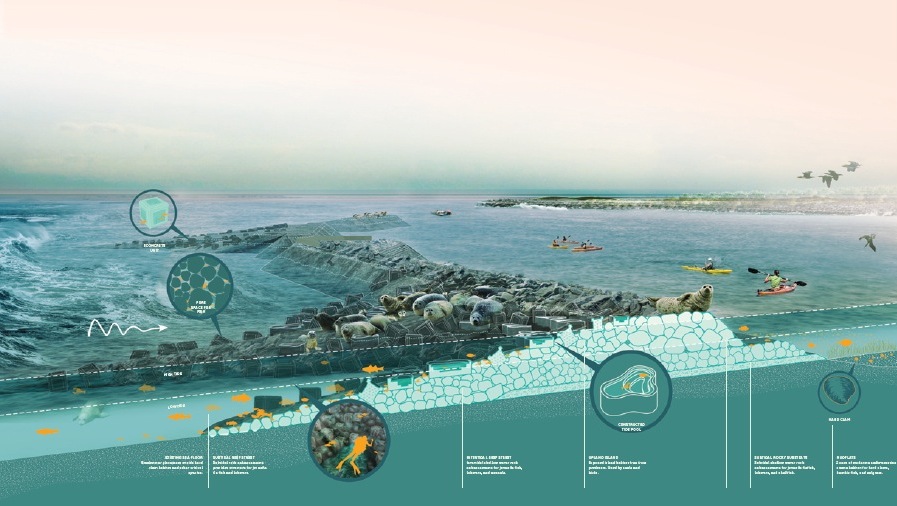New York-based landscape architecture firm SCAPE won the Buckminster Fuller Institute’s 2014 Fuller Challenge, billed as socially responsible design’s highest award.
The development project, Living Breakwaters, is a climate change adaptation plan. A 2014 Fuller Challenge senior advisor and jury member, Bill Browning of Terrapin Bright Green, said about the project: “Living Breakwaters is about dissipating and working with natural energy rather than fighting it. It is on the one hand an engineering and infrastructure-related intervention, but it also has a unique biological function as well. The project team [understands] that you cannot keep back coastal flooding in the context of climate change, but what you can do is ameliorate the force and impact of 100 and 500 year storm surges to diminish the damage through ecological interventions, while simultaneously catalyzing dialog to nurture future stewards of the built environment.”
According to SCAPE, Living Breakwaters “reduces risk, revives ecologies, and connects educators to the shoreline, inspiring a new generation of harbor stewards and a more resilient region over time.”
This is accomplished through a series of projects, including designing “reef street” micro-pockets of habitat complexity to host finfish, shellfish, and lobsters.
A release from the Buckminster Fuller Institute explains that the Living Breakwaters project "integrates components ranging from ecologically engineered ‘Oystertecture,’ to transformational education around coastal resiliency and the restoration of livelihoods traditional to the community of Tottenville in state Island,” while also encouraging systemic change in regulatory pathways at the state level.
Fuller Challenge's Program Manager Sarah Skenazy said, "This year’s Challenge winners deeply know that doing a physical intervention off the coastline would not be enough to create systemic change. Living Breakwaters is a project based in connections—the leadership team brings their deep expertise in technology and ecological science into the social dimension onshore in partnership with the community itself."
On winning the award, SCAPE’s Kate Orff said, "We are so honored to be the 2014 Fuller Challenge recipient. Fuller was optimistic about the future of humanity and deeply believed in cooperation as the way forward. As climate change impacts threaten shoreline populations, Living Breakwaters hopefully represents a paradigm shift in how we collectively address climate risks, by focusing on regenerating waterfront communities and social systems, and enhancing threatened ecosystems."
Orff will accept the Fuller Challenge prize and a $100,000 cash award on behalf of SCAPE at The Wythe in Brooklyn, N.Y., on November 20.
Learn more about the project at SCAPE.
Related Stories
| Aug 11, 2010
Burr Elementary School
In planning the Burr Elementary School in Fairfield, Conn., the school's building committee heeded the words of William Wordsworth: Come forth into the light of things, let nature be your teacher. They selected construction manager Turner Construction Company, New York, and the New York office of A/E firm Skidmore, Owings & Merrill to integrate nature on the heavily wooded 15.
| Aug 11, 2010
Bronze Award: Trenton Daylight/Twilight High School Trenton, N.J.
The story of the Trenton Daylight/Twilight High School is one of renewal and rebirth—both of the classic buildings that symbolize the city's past and the youth that represent its future. The $39 million, 101,000-sf urban infill project locates the high school—which serves recent dropouts and students who are at risk of dropping out—within three existing vacant buildings.
| Aug 11, 2010
New school designs don't go by the book
America needs more schools. Forty-five percent of the nation's elementary, middle, and high schools were built between 1950 and 1969, according market research firm ZweigWhite, Natick, Mass. Yet even as the stock of K-12 schools ages and declines, school enrollments continue to climb. The National Center for Education Statistics predicts that enrollment in public K-12 schools will keep rising...
| Aug 11, 2010
Bronze Award: Lincoln High School Tacoma, Wash.
Lincoln High School in Tacoma, Wash., was built in 1913 and spent nearly a century morphing into a patchwork of outdated and confusing additions. A few years ago, the Tacoma School District picked Lincoln High School, dubbed “Old Main,” to be the first high school in the district to be part of its newly launched Small Learning Communities program.
| Aug 11, 2010
Great Solutions: Technology
19. Hybrid Geothermal Technology The team at Stantec saved $800,000 in construction costs by embedding geothermal piping into the structural piles at the WestJet office complex in Calgary, Alb., rather than drilling boreholes adjacent to the building site, which is the standard approach. Regular geothermal installation would have required about 200 boreholes, each about four-inches in diameter ...
| Aug 11, 2010
Cronkite Communication School Speaks to Phoenix Redevelopment
The city of Phoenix has sprawling suburbs, but its outward expansion caused the downtown core to stagnate—a problem not uncommon to other major metropolitan areas. Reviving the city became a hotbed issue for Mayor Phil Gordon, who envisioned a vibrant downtown that offered opportunities for living, working, learning, and playing.
| Aug 11, 2010
Bronze Award: Hawthorne Elementary School, Elmhurst, Ill.
At 121 years, Hawthorne School is the oldest elementary school building in the Elmhurst, Ill., school district and a source of pride for the community. Unfortunately, decades of modifications and short-sighted planning had rendered it dysfunctional in terms of modern educational delivery. At the same time, increasing enrollment was leading to overcrowding, with the result that the library, for ...
| Aug 11, 2010
Platinum Award: Reviving Oakland's Uptown Showstopper
The story of the Fox Oakland Theater is like that of so many movie palaces of the early 20th century. Built in 1928 based on a Middle Eastern-influenced design by architect Charles Peter Weeks and engineer William Peyton Day, the 3,400-seat cinema flourished until the mid-1960s, when the trend toward smaller multiplex theaters took its toll on the Fox Oakland.







